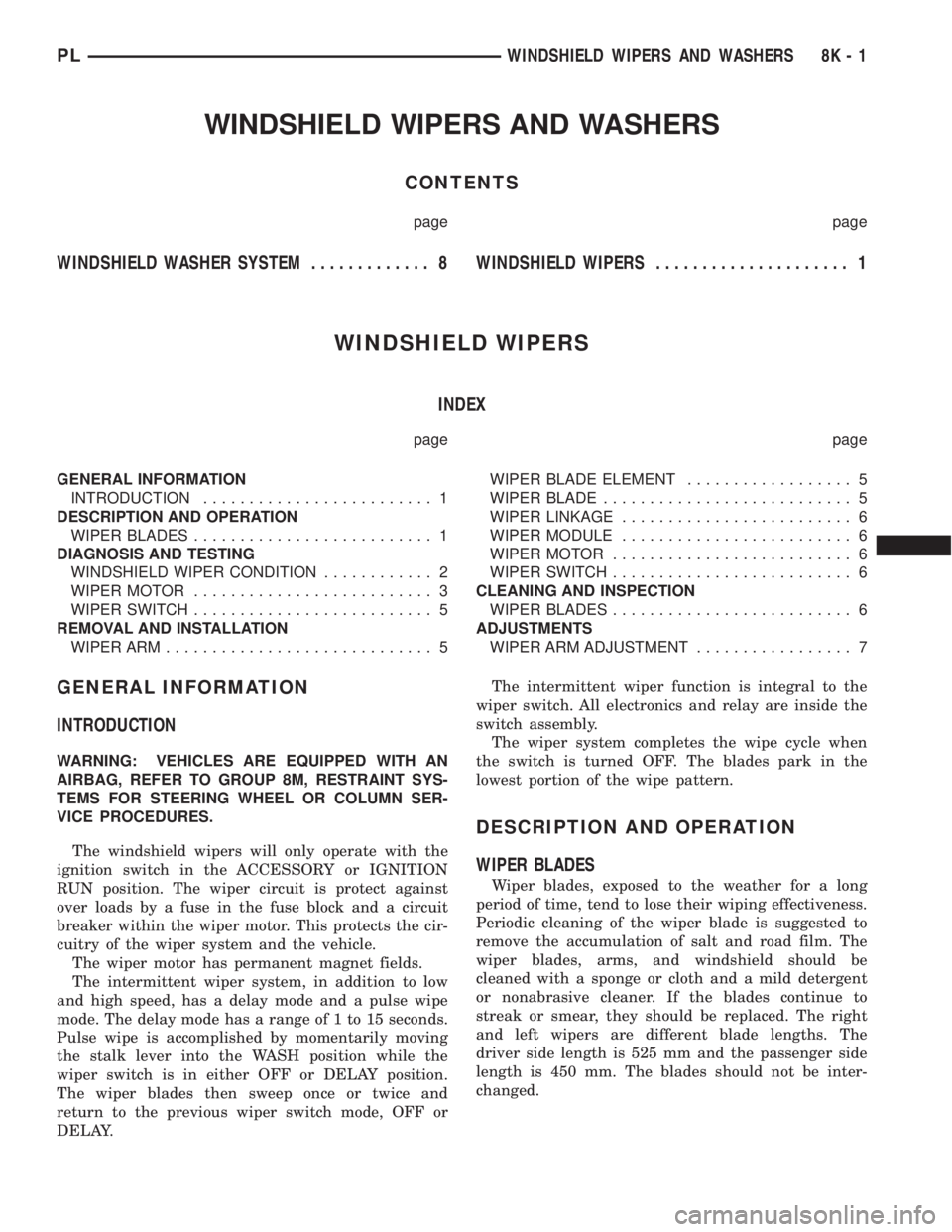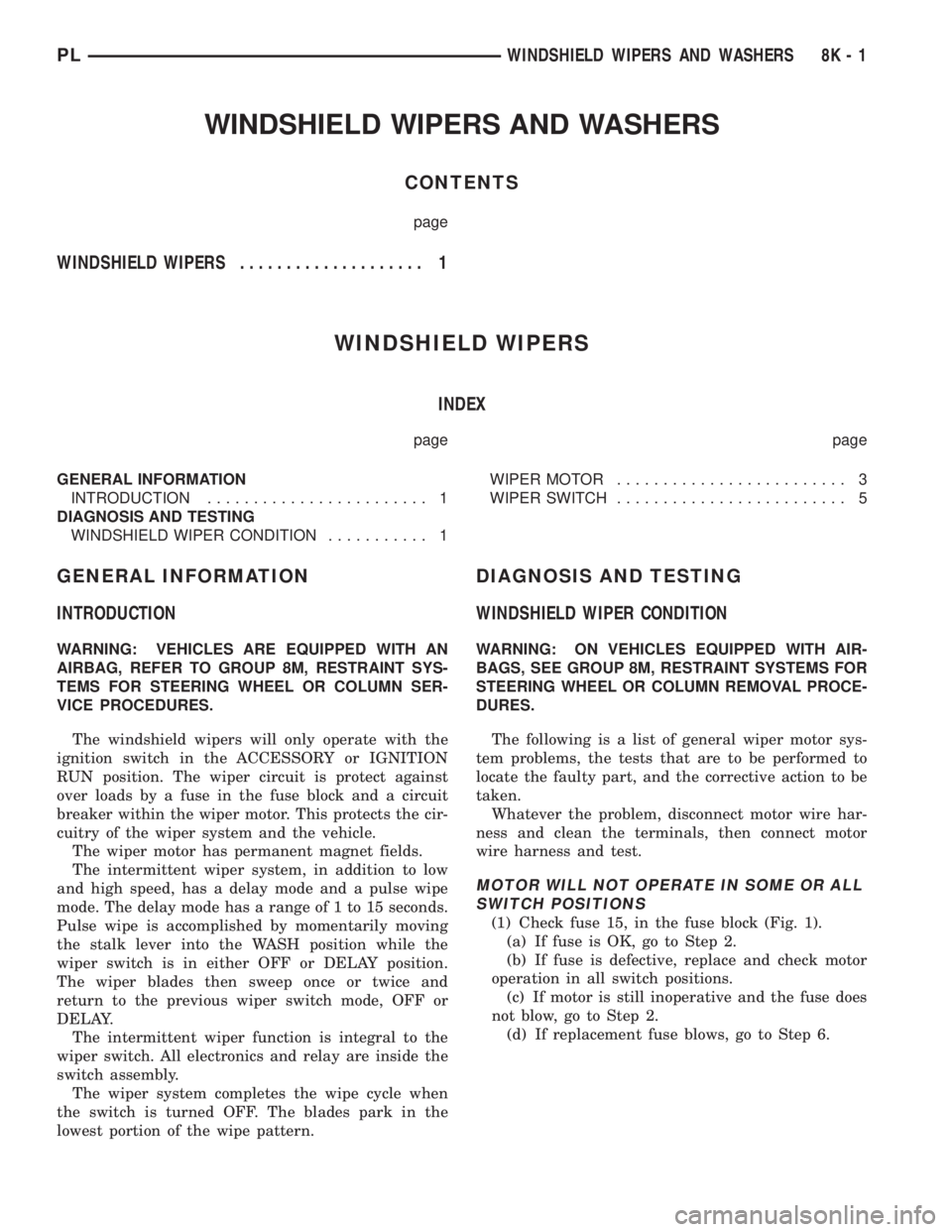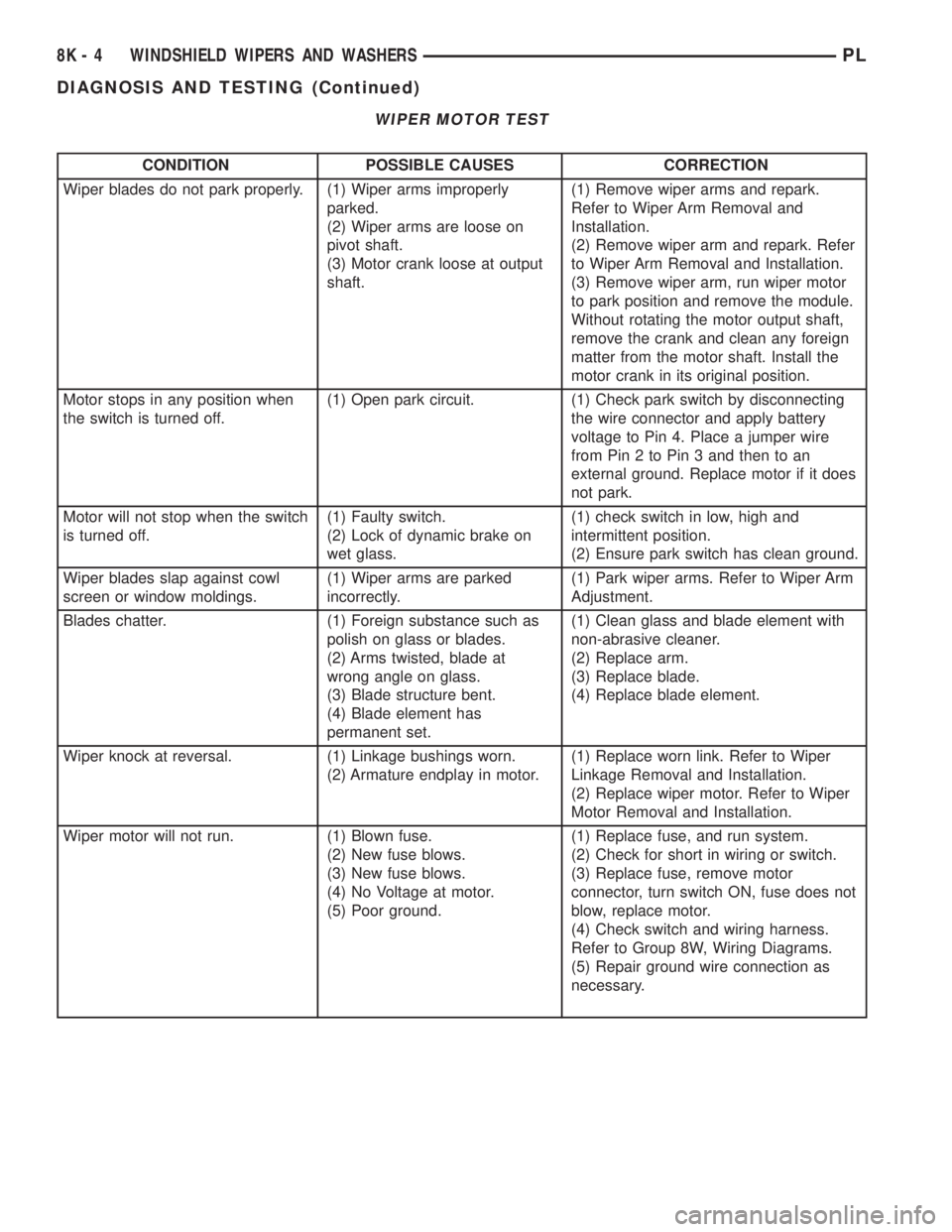1999 DODGE NEON wiper blades
[x] Cancel search: wiper bladesPage 314 of 1200

WINDSHIELD WIPERS AND WASHERS
CONTENTS
page page
WINDSHIELD WASHER SYSTEM............. 8WINDSHIELD WIPERS..................... 1
WINDSHIELD WIPERS
INDEX
page page
GENERAL INFORMATION
INTRODUCTION......................... 1
DESCRIPTION AND OPERATION
WIPER BLADES.......................... 1
DIAGNOSIS AND TESTING
WINDSHIELD WIPER CONDITION............ 2
WIPER MOTOR.......................... 3
WIPER SWITCH.......................... 5
REMOVAL AND INSTALLATION
WIPER ARM............................. 5WIPER BLADE ELEMENT.................. 5
WIPER BLADE........................... 5
WIPER LINKAGE......................... 6
WIPER MODULE......................... 6
WIPER MOTOR.......................... 6
WIPER SWITCH.......................... 6
CLEANING AND INSPECTION
WIPER BLADES.......................... 6
ADJUSTMENTS
WIPER ARM ADJUSTMENT................. 7
GENERAL INFORMATION
INTRODUCTION
WARNING: VEHICLES ARE EQUIPPED WITH AN
AIRBAG, REFER TO GROUP 8M, RESTRAINT SYS-
TEMS FOR STEERING WHEEL OR COLUMN SER-
VICE PROCEDURES.
The windshield wipers will only operate with the
ignition switch in the ACCESSORY or IGNITION
RUN position. The wiper circuit is protect against
over loads by a fuse in the fuse block and a circuit
breaker within the wiper motor. This protects the cir-
cuitry of the wiper system and the vehicle.
The wiper motor has permanent magnet fields.
The intermittent wiper system, in addition to low
and high speed, has a delay mode and a pulse wipe
mode. The delay mode has a range of 1 to 15 seconds.
Pulse wipe is accomplished by momentarily moving
the stalk lever into the WASH position while the
wiper switch is in either OFF or DELAY position.
The wiper blades then sweep once or twice and
return to the previous wiper switch mode, OFF or
DELAY.The intermittent wiper function is integral to the
wiper switch. All electronics and relay are inside the
switch assembly.
The wiper system completes the wipe cycle when
the switch is turned OFF. The blades park in the
lowest portion of the wipe pattern.
DESCRIPTION AND OPERATION
WIPER BLADES
Wiper blades, exposed to the weather for a long
period of time, tend to lose their wiping effectiveness.
Periodic cleaning of the wiper blade is suggested to
remove the accumulation of salt and road film. The
wiper blades, arms, and windshield should be
cleaned with a sponge or cloth and a mild detergent
or nonabrasive cleaner. If the blades continue to
streak or smear, they should be replaced. The right
and left wipers are different blade lengths. The
driver side length is 525 mm and the passenger side
length is 450 mm. The blades should not be inter-
changed.
PLWINDSHIELD WIPERS AND WASHERS 8K - 1
Page 317 of 1200

WIPER SYSTEM DIAGNOSIS
CONDITION POSSIBLE CAUSES CORRECTION
WIPER BLADES DO NOT
PARK PROPERLY1. WIPER ARMS
IMPROPERLY PARKED.
2. WIPER ARMS ARE
LOOSE ON PIVOT SHAFT.
3. MOTOR CRANK LOOSE
AT OUTPUT SHAFT.1. REMOVE WIPER ARMS AND REPARK.
REFER TO WIPER ARM REMOVAL AND
INSTALLATION.
2. REMOVE WIPER ARM AND REPARK.
REFER TO WIPER ARM REMOVAL AND
INSTALLATION.
3. REMOVE WIPER ARM, RUN WIPER
MOTOR TO PARK POSITION AND REMOVE
THE MODULE. WITHOUT ROTATING THE
MOTOR OUTPUT SHAFT, REMOVE THE
CRANK AND CLEAN ANY FOREIGN MATTER
FROM THE MOTOR SHAFT. INSTALL THE
MOTOR CRANK IN ITS ORIGINAL POSITION.
MOTOR STOPS IN ANY
POSITION WHEN THE
SWITCH IS TURNED OFF1. OPEN PARK CIRCUIT. 1. CHECK PARK SWITCH BY
DISCONNECTING THE WIRE CONNECTOR
AND APPLY BATTERY VOLTAGE TO PIN 4.
PLACE A JUMPER WIRE FROM PIN 2 TO
PIN 3 AND THEN TO AN EXTERNAL
GROUND. REPLACE MOTOR IF IT DOES
NOT PARK.
MOTOR WILL NOT STOP
WHEN THE SWITCH IS
TURNED OFF1. FAULTY SWITCH.
2. LOCK OF DYNAMIC
BRAKE ON WET GLASS.1. CHECK SWITCH IN LOW, HIGH AND
INTERMITTENT POSITION.
2. ENSURE PARK SWITCH HAS CLEAN
GROUND.
WIPER BLADES SLAP
AGAINST COWL SCREEN
OR WINDOW MOLDINGS.1. WIPER ARMS ARE
PARKED INCORRECTLY.1. PARK WIPER ARMS. REFER TO WIPER
ARM ADJUSTMENT.
BLADES CHATTER 1. FOREIGN SUBSTANCE
SUCH AS POLISH ON
GLASS OR BLADES.
2. ARMS TWISTED, BLADE
AT WRONG ANGLE ON
GLASS.
3. BLADE STRUCTURE
BENT.
4. BLADE ELEMENT HAS
PERMANENT SET.1. CLEAN GLASS AND BLADE ELEMENT
WITH NON-ABRASIVE CLEANER.
2. REPLACE ARM.
3. REPLACE BLADE.
4. REPLACE BLADE ELEMENT.
WIPER KNOCK AT
REVERSAL1. LINKAGE BUSHINGS
WORN.
2. ARMATURE ENDPLAY IN
MOTOR.1. REPLACE WORN LINK. REFER TO WIPER
LINKAGE REMOVAL AND INSTALLATION.
2. REPLACE WIPER MOTOR. REFER TO
WIPER MOTOR REMOVAL AND
INSTALLATION.
WIPER MOTOR WILL NOT
RUN1. BLOWN FUSE.
2. NEW FUSE BLOWS.
3. NEW FUSE BLOWS.
4. NO VOLTAGE AT MOTOR.
5. POOR GROUND.1. REPLACE FUSE, AND RUN SYSTEM.
2. CHECK FOR SHORT IN WIRING OR
SWITCH.
3. REPLACE FUSE, REMOVE MOTOR
CONNECTOR, TURN SWITCH ON, FUSE
DOES NOT BLOW, REPLACE MOTOR.
4. CHECK SWITCH AND WIRING HARNESS.
REFER TO GROUP 8W, WIRING DIAGRAMS.
5. REPAIR GROUND WIRE CONNECTION AS
NECESSARY.
8K - 4 WINDSHIELD WIPERS AND WASHERSPL
DIAGNOSIS AND TESTING (Continued)
Page 318 of 1200

WIPER SWITCH
To test the switch, first disconnect the switch wires
from the body wiring in the steering column. Using
an ohmmeter, test for continuity between the termi-
nals of the switch, as indicated in the following con-
tinuity chart (Fig. 5).
REMOVAL AND INSTALLATION
WIPER ARM
REMOVAL
(1) Place the wiper arm/blades in the PARK posi-
tion and turn ignition OFF.
(2) Remove arm cap and wiper arm nut.
(3) Remove the arm from the pivot using a rocking
motion.
(4) Clean metal splinters OFF the pivot shafts.
INSTALLATION
For installation reverse above procedures. Before
installation activate wiper system to ensure the
wiper module is in the PARK position. Position wiper
arms so that the heel of the blade(s) is on the park
line on the windshield.
WIPER BLADE
REMOVAL
(1) Lift wiper arm to over center position.
(2) Remove blade assembly from arm by pushing
release tab under arm tip and slide blade away from
arm tip (Fig. 6) and (Fig. 7).
(3) Gently place wiper arm tip on glass surface.
INSTALLATION
For installation reverse above procedures.
WIPER BLADE ELEMENT
REMOVAL
(1) Lift wiper arm to raise blade off glass.
(2) Remove blade assembly from arm by pushing
release tab under arm tip and slide blade away from
arm tip (Fig. 6) and (Fig. 7). Gently place wiper arm
tip on glass surface.
(3) Remove wiping element from blade assembly.
Pull stopper, of the rubber element, out of the end
claw together with vertibra (metal rails) (Fig. 8).
INSTALLATION
For installation reverse the above procedures.
Check that the element and vertibra are through all
claws and the final claw is locked in the stopper.
Fig. 5 Wiper Switch Test
Fig. 6 Wiper Blade and Element
Fig. 7 Remove Blade from Arm
Fig. 8 Wiper Blade and Element
PLWINDSHIELD WIPERS AND WASHERS 8K - 5
DIAGNOSIS AND TESTING (Continued)
Page 319 of 1200

WIPER LINKAGE
REMOVAL
(1) Remove wiper module refer above (Fig. 9).
(2) Disconnect wiper arm linkage, by insert screw-
driver between ball cap and linkage, then twist the
screwdriver and lift straight up on linkage.
INSTALLATION
For installation reverse the above procedures.
Using pliers or hand press the ball cap straight on to
the ball stud.
WIPER MODULE
REMOVAL
(1) Remove wiper arms and blades (Fig. 9).
(2) Remove the rear hood seal with the cowl top
plastic screen.
(3) Disconnect motor wire connector at front ple-
num wall.
(4) Remove wiper module mounting screws and
remove module.
INSTALLATION
For installation reverse the above procedures.
Tighten the mounting screws to 7 to 9 N´m (60 to 80
in. lbs.) torque.
WIPER MOTOR
REMOVAL
(1) Remove wiper module refer above.
(2) Remove linkage from motor crank. Insert
screwdriver between crank and linkage then twist
the screwdriver and lift straight up on linkage.(3) Remove motor mounting screws and remove
motor.
INSTALLATION
For installation add unilube grease to socket and
reverse the above procedures. Tighten the motor
mounting screws to 5 to 6 N´m (45 to 55 in. lbs.)
torque. Tighten drive link nut to 11 to 12 N´m (98 to
106 in. lbs.) torque.
WIPER SWITCH
REMOVAL
(1) Remove three screws holding steering column
shroud and remove upper half of shroud (Fig. 10).
(2) Remove mounting screw on switch and remove
switch.
(3) Disconnect wire harness connector from switch.
INSTALLATION
For installation, reverse the above procedures.
CLEANING AND INSPECTION
WIPER BLADES
Wiper blades exposed to the weather for a long
period of time tend to lose their wiping effectiveness.
Periodic cleaning of the wiper blade is recommended
to remove the accumulation of salt and road grime.
The wiper blades, arms and windshield should be
cleaned with a sponge or cloth and a mild detergent
or nonabrasive cleaner. If the wiper blades continue
to streak or smear, they should be replaced. The
wiper blade should run smoothly across the wind-
shield in both directions. The wiper blade should
slightly roll over center when the blade reverses
direction. A wiper blade insert that has lost flexibility
or a wiper arm that has lost spring tension, will
cause the blade to skip or chatter across the wind-
shield. If the wiper blades are new and the wiper
Fig. 9 Wiper Motor and Linkage Module
Fig. 10 Upper Shroud Removal
8K - 6 WINDSHIELD WIPERS AND WASHERSPL
REMOVAL AND INSTALLATION (Continued)
Page 324 of 1200

WINDSHIELD WIPERS AND WASHERS
CONTENTS
page
WINDSHIELD WIPERS.................... 1
WINDSHIELD WIPERS
INDEX
page page
GENERAL INFORMATION
INTRODUCTION........................ 1
DIAGNOSIS AND TESTING
WINDSHIELD WIPER CONDITION........... 1WIPER MOTOR......................... 3
WIPER SWITCH......................... 5
GENERAL INFORMATION
INTRODUCTION
WARNING: VEHICLES ARE EQUIPPED WITH AN
AIRBAG, REFER TO GROUP 8M, RESTRAINT SYS-
TEMS FOR STEERING WHEEL OR COLUMN SER-
VICE PROCEDURES.
The windshield wipers will only operate with the
ignition switch in the ACCESSORY or IGNITION
RUN position. The wiper circuit is protect against
over loads by a fuse in the fuse block and a circuit
breaker within the wiper motor. This protects the cir-
cuitry of the wiper system and the vehicle.
The wiper motor has permanent magnet fields.
The intermittent wiper system, in addition to low
and high speed, has a delay mode and a pulse wipe
mode. The delay mode has a range of 1 to 15 seconds.
Pulse wipe is accomplished by momentarily moving
the stalk lever into the WASH position while the
wiper switch is in either OFF or DELAY position.
The wiper blades then sweep once or twice and
return to the previous wiper switch mode, OFF or
DELAY.
The intermittent wiper function is integral to the
wiper switch. All electronics and relay are inside the
switch assembly.
The wiper system completes the wipe cycle when
the switch is turned OFF. The blades park in the
lowest portion of the wipe pattern.
DIAGNOSIS AND TESTING
WINDSHIELD WIPER CONDITION
WARNING: ON VEHICLES EQUIPPED WITH AIR-
BAGS, SEE GROUP 8M, RESTRAINT SYSTEMS FOR
STEERING WHEEL OR COLUMN REMOVAL PROCE-
DURES.
The following is a list of general wiper motor sys-
tem problems, the tests that are to be performed to
locate the faulty part, and the corrective action to be
taken.
Whatever the problem, disconnect motor wire har-
ness and clean the terminals, then connect motor
wire harness and test.
MOTOR WILL NOT OPERATE IN SOME OR ALL
SWITCH POSITIONS
(1) Check fuse 15, in the fuse block (Fig. 1).
(a) If fuse is OK, go to Step 2.
(b) If fuse is defective, replace and check motor
operation in all switch positions.
(c) If motor is still inoperative and the fuse does
not blow, go to Step 2.
(d) If replacement fuse blows, go to Step 6.
PLWINDSHIELD WIPERS AND WASHERS 8K - 1
Page 327 of 1200

WIPER MOTOR TEST
CONDITION POSSIBLE CAUSES CORRECTION
Wiper blades do not park properly. (1) Wiper arms improperly
parked.
(2) Wiper arms are loose on
pivot shaft.
(3) Motor crank loose at output
shaft.(1) Remove wiper arms and repark.
Refer to Wiper Arm Removal and
Installation.
(2) Remove wiper arm and repark. Refer
to Wiper Arm Removal and Installation.
(3) Remove wiper arm, run wiper motor
to park position and remove the module.
Without rotating the motor output shaft,
remove the crank and clean any foreign
matter from the motor shaft. Install the
motor crank in its original position.
Motor stops in any position when
the switch is turned off.(1) Open park circuit. (1) Check park switch by disconnecting
the wire connector and apply battery
voltage to Pin 4. Place a jumper wire
from Pin 2 to Pin 3 and then to an
external ground. Replace motor if it does
not park.
Motor will not stop when the switch
is turned off.(1) Faulty switch.
(2) Lock of dynamic brake on
wet glass.(1) check switch in low, high and
intermittent position.
(2) Ensure park switch has clean ground.
Wiper blades slap against cowl
screen or window moldings.(1) Wiper arms are parked
incorrectly.(1) Park wiper arms. Refer to Wiper Arm
Adjustment.
Blades chatter. (1) Foreign substance such as
polish on glass or blades.
(2) Arms twisted, blade at
wrong angle on glass.
(3) Blade structure bent.
(4) Blade element has
permanent set.(1) Clean glass and blade element with
non-abrasive cleaner.
(2) Replace arm.
(3) Replace blade.
(4) Replace blade element.
Wiper knock at reversal. (1) Linkage bushings worn.
(2) Armature endplay in motor.(1) Replace worn link. Refer to Wiper
Linkage Removal and Installation.
(2) Replace wiper motor. Refer to Wiper
Motor Removal and Installation.
Wiper motor will not run. (1) Blown fuse.
(2) New fuse blows.
(3) New fuse blows.
(4) No Voltage at motor.
(5) Poor ground.(1) Replace fuse, and run system.
(2) Check for short in wiring or switch.
(3) Replace fuse, remove motor
connector, turn switch ON, fuse does not
blow, replace motor.
(4) Check switch and wiring harness.
Refer to Group 8W, Wiring Diagrams.
(5) Repair ground wire connection as
necessary.
8K - 4 WINDSHIELD WIPERS AND WASHERSPL
DIAGNOSIS AND TESTING (Continued)